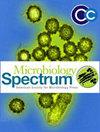Phenotypic and Genotypic Characterization of Multidrug-Resistant Enterobacter hormaechei Carrying qnrS Gene Isolated from Chicken Feed in China
IF 3.8
2区 生物学
Q2 MICROBIOLOGY
引用次数: 1
Abstract
Enterobacter hormaechei is an opportunistic pathogen. It can cause infections in humans and animals. ABSTRACT Multidrug resistance (MDR) in Enterobacteriaceae including resistance to quinolones is rising worldwide. The plasmid-mediated quinolone resistance (PMQR) gene qnrS is prevalent in Enterobacteriaceae. However, the qnrS gene is rarely found in Enterobacter hormaechei (E. hormaechei). Here, we reported one multidrug resistant E. hormaechei strain M1 carrying the qnrS1 and blaTEM-1 genes. This study was to analyze the characteristics of MDR E. hormaechei strain M1. The E. hormaechei strain M1 was identified as Enterobacter cloacae complex by biochemical assay and 16S rRNA sequencing. The whole genome was sequenced by the Oxford Nanopore method. Taxonomy of the E. hormaechei was based on multilocus sequence typing (MLST). The qnrS with the other antibiotic resistance genes were coexisted on IncF plasmid (pM1). Besides, the virulence factors associated with pathogenicity were also located on pM1. The qnrS1 gene was located between insertion element IS2A (upstream) and transposition element ISKra4 (downstream). The comparison result of IncF plasmids revealed that they had a common plasmid backbone. Susceptibility experiment revealed that the E. hormaechei M1 showed extensive resistance to the clinical antimicrobials. The conjugation transfer was performed by filter membrane incubation method. The competition and plasmid stability assays suggested the host bacteria carrying qnrS had an energy burden. As far as we know, this is the first report that E. hormaechei carrying qnrS was isolated from chicken feed. The chicken feed and poultry products could serve as a vehicle for these MDR bacteria, which could transfer between animals and humans through the food chain. We need to pay close attention to the epidemiology of E. hormaechei and prevent their further dissemination. IMPORTANCE Enterobacter hormaechei is an opportunistic pathogen. It can cause infections in humans and animals. Plasmid-mediated quinolone resistance (PMQR) gene qnrS can be transferred intergenus, which is leading to increase the quinolone resistance levels in Enterobacteriaceae. Chicken feed could serve as a vehicle for the MDR E. hormaechei. Therefore, antibiotic-resistance genes (ARGs) might be transferred to the intestinal flora after entering the gastrointestinal tract with the feed. Furthermore, antibiotic-resistant bacteria (ARB) were also excreted into environment with feces, posing a huge threat to public health. This requires us to monitor the ARB and antibiotic-resistant plasmids in the feed. Here, we demonstrated the characteristics of one MDR E. hormaechei isolate from chicken feed. The plasmid carrying the qnrS gene is a conjugative plasmid with transferability. The presence of plasmid carrying antibiotic-resistance genes requires the maintenance of antibiotic pressure. In addition, the E. hormaechei M1 belonged to new sequence type (ST). These data show the MDR E. hormaechei M1 is a novel strain that requires our further research.我国鸡饲料中携带qnrS基因的耐多药肠杆菌的表型和基因型特征
贺氏肠杆菌是一种机会性病原体。它会导致人类和动物感染。摘要肠杆菌科的多药耐药性(MDR)在全球范围内呈上升趋势,其中包括对喹诺酮类药物的耐药性。质粒介导的喹诺酮耐药性(PMQR)基因qnrS在肠杆菌科中普遍存在。然而,qnrS基因很少在贺氏肠杆菌(E.hormaechei)中发现。在这里,我们报道了一株携带qnrS1和blaTEM-1基因的多药耐药E.hormaechei菌株M1。本研究旨在分析耐多药贺氏大肠杆菌M1株的特性。通过生物化学分析和16S rRNA测序,鉴定出贺氏大肠杆菌M1菌株为阴沟肠杆菌复合体。通过Oxford Nanopore方法对整个基因组进行测序。根据多点序列分型(MLST),对禾本科进行了分类。qnrS与其它抗生素抗性基因共存于IncF质粒(pM1)上。此外,与致病性相关的毒力因子也位于pM1上。qnrS1基因位于插入元件IS2A(上游)和转位元件ISKra4(下游)之间。IncF质粒的比较结果显示它们具有共同的质粒骨架。药敏实验表明,贺氏大肠杆菌M1对临床抗菌药物表现出广泛的耐药性。通过滤膜培养法进行缀合转移。竞争和质粒稳定性分析表明携带qnrS的宿主细菌具有能量负荷。据我们所知,这是首次从鸡饲料中分离到携带qnrS的E.hormaechei。鸡饲料和家禽产品可以作为这些耐多药细菌的载体,这些细菌可以通过食物链在动物和人类之间传播。我们需要密切关注贺氏大肠杆菌的流行病学,防止其进一步传播。重要性贺氏肠杆菌是一种机会性病原体。它会导致人类和动物感染。质粒介导的喹诺酮耐药性(PMQR)基因qnrS可以在属间转移,这导致肠杆菌科中喹诺酮耐药性水平的增加。鸡饲料可以作为耐多药大肠杆菌的载体。因此,抗生素抗性基因(ARGs)可能在随饲料进入胃肠道后转移到肠道菌群中。此外,抗生素耐药性细菌(ARB)也随粪便排泄到环境中,对公众健康构成巨大威胁。这需要我们监测饲料中的ARB和抗生素抗性质粒。在这里,我们展示了一种从鸡饲料中分离的耐多药贺氏大肠杆菌的特性。携带qnrS基因的质粒是具有可转移性的偶联质粒。携带抗生素抗性基因的质粒的存在需要维持抗生素压力。此外,E.hormaechei M1属于新序列型(ST)。这些数据表明MDR E.hormaechei M1是一种需要我们进一步研究的新菌株。
本文章由计算机程序翻译,如有差异,请以英文原文为准。
求助全文
约1分钟内获得全文
求助全文
来源期刊

Microbiology spectrum
Biochemistry, Genetics and Molecular Biology-Genetics
CiteScore
3.20
自引率
5.40%
发文量
1800
期刊介绍:
Microbiology Spectrum publishes commissioned review articles on topics in microbiology representing ten content areas: Archaea; Food Microbiology; Bacterial Genetics, Cell Biology, and Physiology; Clinical Microbiology; Environmental Microbiology and Ecology; Eukaryotic Microbes; Genomics, Computational, and Synthetic Microbiology; Immunology; Pathogenesis; and Virology. Reviews are interrelated, with each review linking to other related content. A large board of Microbiology Spectrum editors aids in the development of topics for potential reviews and in the identification of an editor, or editors, who shepherd each collection.
 求助内容:
求助内容: 应助结果提醒方式:
应助结果提醒方式:


